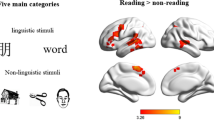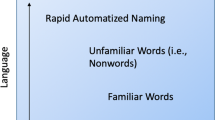Abstract
It has been suggested that the cerebellum is involved in reading acquisition and in particular in the progression from automatic grapheme–phoneme conversion to the internalization of speech required for silent reading. This idea is in line with clinical and neuroimaging data showing a cerebellar role in subvocal rehearsal for printed verbalizable material and with computational “internal models” of the cerebellum suggesting its role in inner speech (i.e. covert speech without mouthing the words). However, studies examining a possible cerebellar role in the suppression of articulatory movements during silent reading acquisition in children are lacking. Here, we report clinical evidence that the cerebellum plays a part in this transition. Reading performances were compared between a group of 17 paediatric patients treated for benign cerebellar tumours and a group of controls matched for age, gender, and parental socio-educational level. The patients scored significantly lower on all reading, but the most striking difference concerned silent reading, perfectly acquired by almost all controls, contrasting with 41 % of the patients who were unable to read any item silently. Silent reading was correlated with the Working Memory Index. The present findings converge with previous reports on an implication of the cerebellum in inner speech and in the automatization of reading. This cerebellar implication is probably not specific to reading, as it also seems to affect non-reading tasks such as counting.


Similar content being viewed by others
References
Leiner HC, Leiner AL, Dow RS. Does the cerebellum contribute to mental skills? Behav Neurosci. 1986;100(4):443–54.
Schmahmann JD, Sherman JC. The cerebellar cognitive affective syndrome. Brain. 1998;121(4):561–79.
Levisohn L, Cronin-Golomb A, Schmahmann JD. Neuropsychological consequences of cerebellar tumour resection in children: cerebellar cognitive affective syndrome in a paediatric population. Brain. 2000;123(5):1041–50.
Mariën P, Ackermann H, Adamaszek M, Barwood CHS, Beaton A, Desmond J, et al. Consensus paper: language and the cerebellum: an ongoing enigma. Cerebellum. 2014;13(3):386–410.
Leggio MG, Chiricozzi FR, Clausi S, Tedesco AM, Molinari M. The neuropsychological profile of cerebellar damage: the sequencing hypothesis. Cortex. 2011;47(1):137–44.
Ackermann H, Gräber S, Hertrich I, Daum I. Cerebellar contributions to the perception of temporal cues within the speech and nonspeech domain. Brain Lang. 1999;67(3):228–41.
Ben-Yehudah G, Fiez JA. Impact of cerebellar lesions on reading and phonological processing. Ann N Y Acad Sci. 2008;1145:260–74.
Moretti R, Bava A, Torre P, Antonello RM, Cazzato G. Reading errors in patients with cerebellar vermis lesions. J Neurol. 2002;249(4):461–8.
Leroy-Boussion A. La lecture silencieuse. Psy. 1966;66(2):579–98.
Baddeley A. Working memory: looking back and looking forward. Nat Rev Neurosci. 2003;4(10):829–39.
Baddeley A, Lewis VJ, Vallar G. Exploring the articulatory loop. In: Quarterly journal of experimental psychology. 1984;36 (A):233–252.
Paulesu E, Frith CD, Frackowiak RS. The neural correlates of the verbal component of working memory. Nature. 1993;362(6418):342–5.
Desmond JE, Gabrieli JD, Wagner AD, Ginier BL, Glover GH. Lobular patterns of cerebellar activation in verbal working-memory and finger-tapping tasks as revealed by functional MRI. J Neurosci. 1997;17(24):9675–85.
Chen SHA, Desmond JE. Temporal dynamics of cerebro-cerebellar network recruitment during a cognitive task. Neuropsychologia. 2005;43(9):1227–37.
Chen SHA, Desmond JE. Cerebrocerebellar networks during articulatory rehearsal and verbal working memory tasks. Neuroimage. 2005;24(2):332–8.
Sternberg S. High-speed scanning in human memory. Science. 1966;153:652–4.
Kirschen MP, Chen SHA, Schraedley-Desmond P, Desmond JE. Load- and practice- dependent increases in cerebro-cerebellar activation in verbal working memory: an fMRI study. Neuroimage. 2005;24(2):462–72.
Kirschen MP, Chen SHA, Desmond JE. Modality specific cerebro-cerebellar activations in verbal working memory: an fMRI study. Behav Neurol. 2010;23(1–2):51–63.
Marvel CL, Desmond JE. Functional topography of the cerebellum in verbal working memory. Neuropsychol Rev. 2010;20(3):271–9.
Nicolson RI, Fawcett AJ. Automaticity: a new framework for dyslexia research? Cognition. 1990;35(2):159–82.
Nicolson RI, Fawcett AJ, Dean P. Developmental dyslexia: the cerebellar deficit hypothesis. Trends Neurosci. 2001;24(9):508–11.
Fawcett AJ, Nicolson RI. Performance of dyslexic children on cerebellar and cognitive tests. J Mot Behav. 1999;31(1):68–78.
Nicolson RI, Fawcett AJ, Berry EL, Jenkins IH, Dean P, Brooks DJ. Association of abnormal cerebellar activation with motor learning difficulties in dyslexic adults. Lancet. 1999;353(9165):1662–7.
Ito M. Control of mental activities by internal models in the cerebellum. Nat Rev Neurosci. 2008;9(4):304–13.
Daneman M, Newson M. Assessing the importance of subvocalization during normal silent reading. Read Writ. 1992;4(1):55–77.
Von Aster M, Dellatolas G. ZAREKI-R: Manuel d’utilisation. Paris: ECPA; 2006.
Trouillas P, Takayanagi T, Hallett M, Currier RD, Subramony SH, Wessel K, et al. International Cooperative Ataxia Rating Scale for pharmacological assessment of the cerebellar syndrome. The Ataxia Neuropharmacology Committee of the World Federation of Neurology J Neurol Sci. 1997;145(2):205–11.
Wechsler d. WISC-IV Echelle d'Intelligence de Wechsler pour Enfants et Adolescents. 4 th ed. Paris : ECPA; 2005.
Lefavrais P. Alouette-R Test d’Analyse de la Lecture et de la Dyslexie. Paris: ECPA; 2005.
Kaufman AS, Kaufman NL. Kaufman Assessment Battery for Children. 2nd ed. Circle Pines, MN: American Guidance Service; 2004.
Puget S, Boddaert N, Viguier D, Kieffer V, Bulteau C, Garnett M, et al. Injuries to inferior vermis and dentate nuclei predict poor neurological and neuropsychological outcome in children with malignant posterior fossa tumors. Cancer. 2009;115(6):1338–47.
SAS Institute INC SAS/STAT. User’s guide, version 6. 4th ed., Vol. 1. Cary, NC; 1989.
Pitsika M, Tsitouras V. Cerebellar mutism. J Neurosurg Pediatr. 2013;12(6):604–14.
Castro-Caldas A, Petersson KM, Reis A, Stone-Elander S, Ingvar M. The illiterate brain. Learning to read and write during childhood influences the functional organization of the adult brain. Brain. 1998;121(Pt 6):1053–63.
Dellatolas G, Willadino Braga L, Do N Souza L, Filho GN, Queiroz E, Deloche G. Cognitive consequences of early phase of literacy. J Int Neuropsychol Soc. 2003;9(5):771–82.
Gathercole SE, Willis C, Emslie H, Baddeley AD. The influences of number of syllables and word-likeness on children’s repetition of nonwords. Applied Psycholinguistics. 1991;12:349–67.
De Jong PF, van der Leij A. Specific contributions of phonological abilities to early reading acquisition: results from a Dutch latent variable longitudinal study. Journal of Educational Psychology. 1999;91(3):450–76.
Ben-Yehudah G, Guediche S, Fiez JA. Cerebellar contributions to verbal working memory: beyond cognitive theory. Cerebellum. 2007;6(3):193–201.
Marvel CL, Faulkner ML, Strain EC, Mintzer MZ, Desmond JE. An fMRI investigation of cerebellar function during verbal working memory in methadone maintenance patients. Cerebellum. 2012;11(1):300–10.
Vygotski L. Pensée et mots. In Pensée et langage. 3 rd ed. 1st ed: 1933. Paris: La dispute; 1997. pp. 415–500.
Schlösser R, Hutchinson M, Joseffer S, Rusinek H, Saarimaki A, Stevenson J, et al. Functional magnetic resonance imaging of human brain activity in a verbal fluency task. J Neurol Neurosurg Psychiatr. 1998;64(4):492–8.
Murray DJ. The effect of white noise upon the recall of vocalized lists. Can J Psychol. 1965;19(4):333–45.
Ravizza SM, Delgado MR, Chein JM, Becker JT, Fiez JA. Functional dissociations within the inferior parietal cortex in verbal working memory. Neuroimage. 2004;22(2):562–73.
Marvel CL, Desmond JE. The contributions of cerebro-cerebellar circuitry to executive verbal working memory. Cortex. 2010;46(7):880–95.
Strick PL, Dum RP, Fiez JA. Cerebellum and nonmotor function. Annu Rev Neurosci. 2009;32:413–34.
Ravizza SM, McCormick CA, Schlerf JE, Justus T, Ivry RB, Fiez JA. Cerebellar damage produces selective deficits in verbal working memory. Brain. 2006;129:306–20.
Koziol LF, Budding D, Andreasen N, D’Arrigo S, Bulgheroni S, Imamizu H, et al. Consensus paper: the cerebellum’s role in movement and cognition. Cerebellum. 2014;13(1):151–77.
Acknowledgments
N. Ait Khelifa-Gallois was supported by grants from Cancéropôle Ile de France and Ligue contre le cancer. We thank the participants for their contribution to this study.
Declaration
The authors report no conflicts of interest. The authors alone are responsible for the content and writing of this article.
Author information
Authors and Affiliations
Corresponding author
Electronic Supplementary Material
Rights and permissions
About this article
Cite this article
Ait Khelifa-Gallois, N., Puget, S., Longaud, A. et al. Clinical Evidence of the Role of the Cerebellum in the Suppression of Overt Articulatory Movements During Reading. A Study of Reading in Children and Adolescents Treated for Cerebellar Pilocytic Astrocytoma. Cerebellum 14, 97–105 (2015). https://doi.org/10.1007/s12311-014-0612-1
Published:
Issue Date:
DOI: https://doi.org/10.1007/s12311-014-0612-1





